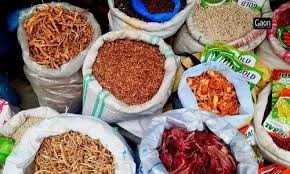
As winter approaches in Srinagar, the capital city of Jammu and Kashmir, preparations are in full swing, and one of the notable practices is the drying of vegetables. This age-old method is essential for residents to ensure a stable food supply during the harsh winter months when fresh produce is limited due to heavy snowfall and freezing temperatures.
Drying Vegetables for Winter:
Preservation Method: Farmers and homemakers in Srinagar dry a variety of vegetables, such as tomatoes, green beans, carrots, and spinach, by slicing them thinly and drying them under the sun or in traditional drying houses. This helps preserve the vegetables for months, providing nutrition when fresh produce is unavailable.
Cultural Tradition: Drying vegetables is a well-established tradition in the region, passed down through generations. The practice is not only practical but also a cultural ritual that connects the people to their agricultural heritage.
Market Preparation: Local markets see a surge in dried vegetable sales, as residents prepare for the long winter. These dried vegetables are rehydrated when needed, making them an essential part of winter diets in the region.
Complementing Traditional Cuisines: Dried vegetables are used in a variety of traditional Kashmiri dishes, such as the famous Gushtaba (meatball curry) and Kahwa (Kashmiri tea), ensuring the flavors remain intact even during the off-season.
This practice not only helps in sustaining the population throughout the winter months but also supports the local economy, as dried vegetables become a key component of both domestic consumption and regional trade.
As winter approaches in Srinagar, the capital city of Jammu and Kashmir, preparations are in full swing, and one of the notable practices is the drying of vegetables. This age-old method is essential for residents to ensure a stable food supply during the harsh winter months when fresh produce is limited due to heavy snowfall and freezing temperatures.
Drying Vegetables for Winter:
Preservation Method: Farmers and homemakers in Srinagar dry a variety of vegetables, such as tomatoes, green beans, carrots, and spinach, by slicing them thinly and drying them under the sun or in traditional drying houses. This helps preserve the vegetables for months, providing nutrition when fresh produce is unavailable.
Cultural Tradition: Drying vegetables is a well-established tradition in the region, passed down through generations. The practice is not only practical but also a cultural ritual that connects the people to their agricultural heritage.
Market Preparation: Local markets see a surge in dried vegetable sales, as residents prepare for the long winter. These dried vegetables are rehydrated when needed, making them an essential part of winter diets in the region.
Complementing Traditional Cuisines: Dried vegetables are used in a variety of traditional Kashmiri dishes, such as the famous Gushtaba (meatball curry) and Kahwa (Kashmiri tea), ensuring the flavors remain intact even during the off-season.
This practice not only helps in sustaining the population throughout the winter months but also supports the local economy, as dried vegetables become a key component of both domestic consumption and regional trade.
© Copyright 2023 brighterkashmir.com All Rights Reserved. Quantum Technologies